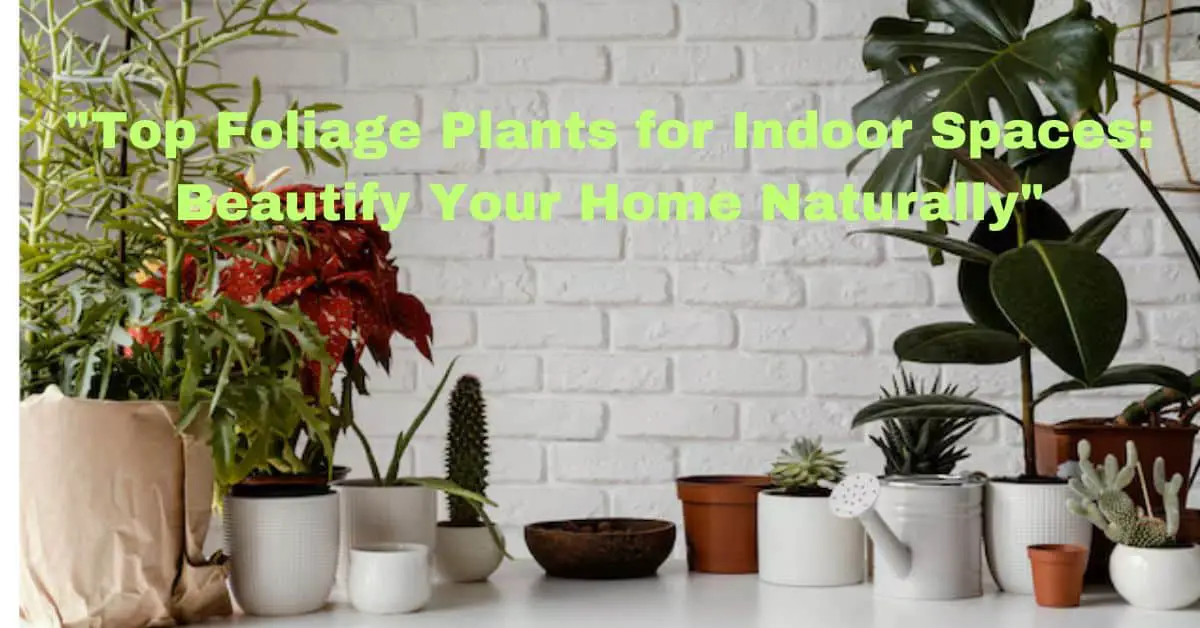Top Foliage Plants for Indoor Spaces: Beautify Your Home Naturally
Indoor foliage plants do more than add greenery; they bring a sense of calm, beauty, and fresh air to any room. From dramatic leaves to lush textures, foliage plants are ideal for elevating indoor spaces with natural elegance. But what’s the best way to choose and care for them? If you’re ready to turn your home into a relaxing, plant-filled sanctuary, here are some tips on picking and maintaining indoor foliage plants, even for beginners.
Table of Contents
Why Foliage Plants Are Perfect for Indoors
Foliage plants are popular because they bring versatility and low-maintenance beauty to indoor environments. Many foliage plants, like pothos, philodendrons, and ferns, thrive with minimal sunlight, making them perfect for indoor settings where light can be limited. Plus, they’re natural air purifiers, which is a bonus for anyone looking to improve indoor air quality.
Whether you’re looking for large, statement plants or smaller ones for shelf décor, indoor foliage plants come in many varieties to suit every taste and space.
Choosing the Right Foliage Plants for Your Space
With so many beautiful foliage plants to choose from, it helps to know a little about each variety’s needs to select plants that will thrive in your home’s unique conditions.
1. Low-Light Loving Foliage Plants
- Snake Plant (Sansevieria): This plant is a powerhouse when it comes to resilience. Not only can it tolerate low light, but it also needs minimal watering, making it perfect for those who are new to plant care or tend to forget watering schedules.
- ZZ Plant: Known for its waxy, dark green leaves, the ZZ plant can thrive in low-light corners. It’s ideal for offices, hallways, and shaded living rooms.
2. Bright Light Beauties
- Rubber Plant (Ficus elastica): Rubber plants love bright, indirect light. They can grow tall with large, glossy leaves, making them an eye-catching focal point in any room.
- Areca Palm: This graceful palm can grow up to 7 feet indoors when provided with enough sunlight, bringing a tropical feel to spaces with ample light.
3. Humidity Lovers
- Boston Fern: Boston ferns love humidity and indirect light, so they’re ideal for bathrooms or kitchens with decent natural light. Their lush, feathery fronds add softness and a sense of fullness to any room.
- Peace Lily: With its glossy green leaves and occasional white blooms, the peace lily does well in humid environments. It’s a great option for adding elegance and natural air purification to any space.
Care Tips for Foliage Plants
Most foliage plants are easy to care for, but keeping a few essentials in mind will help you maintain vibrant, healthy plants.
1. Water Wisely
- Routine Matters: Foliage plants vary in their water needs, but overwatering is a common issue. Plants like snake plants and ZZ plants prefer to dry out between watering, while ferns and peace lilies prefer slightly moist soil.
- Know Your Plant’s Needs: Use a moisture meter if you’re unsure, or simply feel the soil with your fingers. Most foliage plants thrive when their top inch of soil is dry before watering.
2. Light Requirements
- Adjust Placement as Needed: Keep an eye on your plant’s leaves for signs they need more or less light. If leaves are yellowing, your plant may be getting too much direct sunlight. If they’re turning pale, they might need more light.
- Rotate Regularly: Rotating plants every few weeks can help them grow evenly by exposing all sides to light.
3. Humidity Boosts
- Misting for Tropical Plants: Plants like ferns and peace lilies benefit from misting or a nearby humidifier. Grouping plants together can also create a mini humidity zone for their benefit.
- Pebble Trays: Place a shallow tray of water and pebbles under the pot. As water evaporates, it adds moisture to the air around the plant.
Real-Life Examples of Foliage Plant Success
When I first started incorporating foliage plants into my home, I chose a few low-maintenance plants like the ZZ plant and pothos, as they didn’t need much sunlight or water. I placed the pothos on a high shelf where it could drape down, creating a beautiful cascading effect. It was incredible how much life and color these plants added to my small apartment without needing constant care.
Over time, I ventured into adding some humidity-loving plants, like the Boston fern. At first, I struggled to keep it from drying out, but by misting it every few days and placing it in the bathroom, it eventually thrived and added a lush, green vibe to the room.
Styling Tips for Indoor Foliage Plants
Foliage plants can also be a creative way to decorate. Here are a few ideas:
- Shelf Appeal: Plants like pothos or philodendron can be placed on high shelves, allowing their vines to cascade downward for a beautiful effect.
- Statement Corners: A rubber plant or a large snake plant in a decorative pot can fill an empty corner with character. Pairing it with a modern plant stand elevates the look.
- Hanging Baskets: Small foliage plants, such as spider plants or English ivy, look stunning in hanging baskets. They add visual interest without taking up floor space.
- Grouping Plants Together: Create a small indoor jungle by clustering plants with different textures and leaf shapes. The variety makes the arrangement visually engaging while providing a humidity boost as plants release moisture into the air.
Common Mistakes with Indoor Foliage Plants
Even with the best intentions, it’s easy to make a few mistakes with foliage plants. Here’s what to avoid:
- Overwatering: The number one mistake with foliage plants. Even humidity-loving plants don’t need to be soaked every time. Adjust watering according to your plant’s specific needs.
- Ignoring Light Needs: While many foliage plants tolerate low light, few truly thrive in dark rooms. Ensure they get the right amount of light to stay healthy.
- Skipping Routine Maintenance: Dusty leaves can reduce a plant’s ability to photosynthesize. Take a damp cloth and gently wipe leaves every few weeks to keep them clean and able to absorb light efficiently.
Choosing the Right Pot and Soil for Foliage Plants
The pot and soil play a big role in plant health:
- Drainage Is Key: Choose pots with drainage holes to avoid waterlogging roots, which can lead to root rot.
- Well-Draining Soil: Most foliage plants do well in a general potting mix that offers good aeration. For succulents, use a cactus mix to prevent the soil from retaining too much water.
Final Thoughts: Finding Joy in Foliage Plants
Adding foliage plants to your indoor space is one of the simplest ways to create a calm, inviting environment. These plants don’t just improve aesthetics; they help purify the air, increase humidity, and can even improve your mood.
Whether you’re a beginner or a seasoned plant lover, foliage plants make it easy to add a touch of nature indoors. So go ahead—choose a few of your favourites, find them a sunny (or shaded) spot, and let your indoor garden flourish.
Bringing foliage plants indoors is like inviting a bit of the natural world into your home, and with a little care, they’ll reward you with beauty and freshness for years to come.










